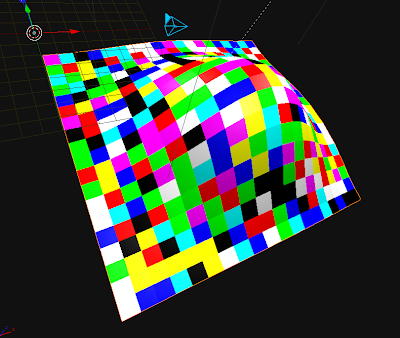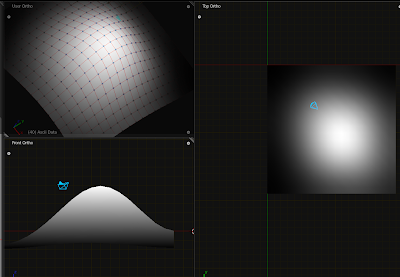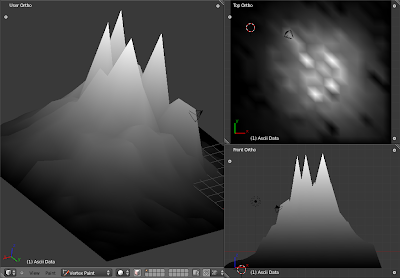# remap.py python 3.2 blender 2.57 r37243
# GPL2 license
# Author Dealga McArdle
import bpy
from mathutils import Vector
def remap(current, lower_old, upper_old, lower_new, upper_new):
'''
Remaps one range of values to another range of values, types must be float
arguments : Description
----------------------------------------------------------
current : Value to fit within the destination range
lower_old : Lowest value of the original range
upper_old : Highest value of the original range
lower_new : Lowest value of the destination range
upper_new : Highest value of the destination range
'''
# type checking, if any of the arguments are not float then return None.
lcheck = current, lower_old, upper_old, lower_new, upper_new
lstr = "current", "lower_old", "upper_old", "lower_new", "upper_new"
for i in range(len(lcheck)):
if lcheck[i].__class__ is not float:
print(lstr[i], "is not a float")
return None
# before calculations we can deal with some possible errors
if current <= lower_old: return lower_new
if current >= upper_old: return upper_new
# reusing a nicely coded Vector math utility :)
old_min = Vector((0.0, 0.0, lower_old))
old_max = Vector((0.0, 0.0, upper_old))
new_min = Vector((0.0, 0.0, lower_new))
new_max = Vector((0.0, 0.0, upper_new))
# calculate spread, fast and saves room!
spread_old = (old_max-old_min).length
spread_new = (new_max-new_min).length
factor_remap = spread_new / spread_old
current_vector = Vector((0.0, 0.0, current))
remap_temp = (current_vector-old_min).length
remapped = (remap_temp * factor_remap) + new_min[2]
# clamp output when rounding creates values beyond new range
if remapped < lower_new: return lower_new
if remapped > upper_new: return upper_new
# value seems alright!
return remapped
Featured post
new redirect for blender.org bpy docs.
http://www.blender.org/api/blender_python_api_current/ As of 10/11 november 2015 we can now link to the current api docs and not be worr...
Showing posts with label remap. Show all posts
Showing posts with label remap. Show all posts
June 06, 2011
remap with input error checking
some thoughts on the remap function, this includes some invalid input checking.
June 05, 2011
Vertex Colours (Z height to colour)
note to user: for blender 2.62, replace 'faces' with 'polygons' - Most of this post contains information that is of little relevance to Blender 2.6x
Here is a link to updated version of this: update for 2.6x
so you can manipulate the data according to (for example) their Z value.

this checks their Z height and makes them lighter at heigher Z-values. First it checks the highest Z value and lowest Z value in the coordinate list for those Faces, then adjusts the Height-to-VertexColor function accordingly
This is much longer because it includes the remap function, which i'm sure could be done with one function call, like in actionscript or processing. EDIT: for an updated version of the remap function used below visit remap-with-input-error-checking


Here is a link to updated version of this: update for 2.6x
below this point is outdated information
say you have just painted vertex colours in Vertex Paint mode.
>>> for i in bpy.context.active_object.data.vertex_colors[0].data:
# for every face print, color4 only useful in a Quad mesh.
... print(i.color1, i.color2, i.color3, i.color4)
will print layer 0 of Vertex Colors for that mesh object. This property is read/writeso you can manipulate the data according to (for example) their Z value.
# set everything to a midtone rgb Color((.5, .5, .5))
# modify vertex painted 'Vertex Colors' palette
import bpy
import random
from mathutils import Color
for i in bpy.context.active_object.data.vertex_colors[0].data:
i.color1 = Color((0.5, 0.5, 0.5))
i.color2 = Color((0.5, 0.5, 0.5))
i.color3 = Color((0.5, 0.5, 0.5))
i.color4 = Color((0.5, 0.5, 0.5))
this makes all colours utterly random ( super ugly! )
# modify vertex painted 'Vertex Colors' palette
import bpy
import random
from mathutils import Color
for i in bpy.context.active_object.data.vertex_colors[0].data:
r = random.randint(0,1)
g = random.randint(0,1)
b = random.randint(0,1)
VertCol = (r,g,b)
i.color1 = Color((VertCol))
i.color2 = Color((VertCol))
i.color3 = Color((VertCol))
i.color4 = Color((VertCol))

this checks their Z height and makes them lighter at heigher Z-values. First it checks the highest Z value and lowest Z value in the coordinate list for those Faces, then adjusts the Height-to-VertexColor function accordingly
This is much longer because it includes the remap function, which i'm sure could be done with one function call, like in actionscript or processing. EDIT: for an updated version of the remap function used below visit remap-with-input-error-checking
# modify vertex painted 'Vertex Colors' palette
import bpy
import random
from mathutils import Color, Vector
def remap(current, lower_old, upper_old, lower_new, upper_new):
# error spreads must return difference between the values
old_tup = lower_old, upper_old
new_tup = lower_new, upper_new
# reusing a nicely coded Vector math utility :)
old_min = Vector((0.0, 0.0, lower_old))
old_max = Vector((0.0, 0.0, upper_old))
new_min = Vector((0.0, 0.0, lower_new))
new_max = Vector((0.0, 0.0, upper_new))
# fast and saves room!
spread_old = (old_max-old_min).length
spread_new = (new_max-new_min).length
factor_remap = spread_new / spread_old
current_vector = Vector((0.0, 0.0, current))
remap_temp =(current_vector-old_min).length
remapped = (remap_temp * factor_remap) + new_min[2]
# i think color values are clamped by blender, but it is
# good practice to not take this for granted in all cases.
if remapped < lower_new: return lower_new
if remapped > upper_new: return upper_new
# value seems alright!
return remapped
# Find upper and lower z values.
# there are many ways to skin this cat, but i'm going to be lazy
z_list = []
for i in bpy.context.active_object.data.vertices:
z_list.append(i.co.z)
z_list = sorted(z_list)
print('lower z',z_list[0])
print('upper z',z_list[len(z_list)-1])
lower_old = z_list[0]
upper_old = z_list[len(z_list)-1]
lower_new = 0.0
upper_new = 1.0
vertlist = bpy.context.active_object.data.vertices
facelist = bpy.context.active_object.data.faces
colorlist = bpy.context.active_object.data.vertex_colors[0].data
for i in range(len(colorlist)):
remapped = []
for element in range(4):
vertnum1 = facelist[i].vertices[element]
remap_1 = vertlist[vertnum1].co.z
remap_1 = remap(remap_1, lower_old, upper_old, lower_new, upper_new)
remapped.append(Color((remap_1,remap_1,remap_1)))
colorlist[i].color1 = remapped[0]
colorlist[i].color2 = remapped[1]
colorlist[i].color3 = remapped[2]
colorlist[i].color4 = remapped[3]


Subscribe to:
Posts (Atom)